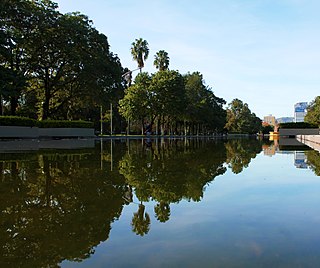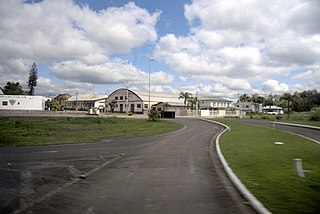
Porto Alegre is the capital and largest city of the Brazilian state of Rio Grande do Sul. Its population of 1,488,252 inhabitants (2020) makes it the 12th-most populous city in the country and the center of Brazil's fifth-largest metropolitan area, with 4,405,760 inhabitants (2010). The city is the southernmost capital city of a Brazilian state.

Rio Grande do Sul is a state in the southern region of Brazil. It is the fifth-most populous state and the ninth-largest by area. Located in the southernmost part of the country, Rio Grande do Sul is bordered clockwise by Santa Catarina to the north and northeast, the Atlantic Ocean to the east, the Uruguayan departments of Rocha, Treinta y Tres, Cerro Largo, Rivera, and Artigas to the south and southwest, and the Argentine provinces of Corrientes and Misiones to the west and northwest. The capital and largest city is Porto Alegre. The state has the highest life expectancy in Brazil, and the crime rate is relatively low compared to the Brazilian national average. Despite the high standard of living, unemployment is still high in the state, as of 2017. The state has 5.4% of the Brazilian population and is responsible for 6.6% of the Brazilian GDP.

Caxias do Sul is a city in Rio Grande do Sul, Southern Brazil, situated in the state's mountainous Serra Gaúcha region. It was established by Italian immigrants on June 20, 1890. Today it is the second largest city in the state of Rio Grande do Sul. In 2020, the population of Caxias do Sul was estimated at 517,451 people, many of whom are of Italian and German descent. The demonym of the citizens of Caxias do Sul is Caxiense.

The Ragamuffin War or Ragamuffin Revolution was a Republican uprising that began in southern Brazil, in the province of Rio Grande do Sul in 1835. The rebels were led by generals Bento Gonçalves da Silva and Antônio de Sousa Neto with the support of the Italian fighter Giuseppe Garibaldi. The war ended with an agreement between the two sides known as Green Poncho Treaty in 1845.

Guaíba is a city located in the Metropolitan Porto Alegre of Porto Alegre, in the Brazilian state of Rio Grande do Sul. The city is on the shores of the Guaíba Lake.

Grêmio Foot-Ball Porto Alegrense, commonly known as Grêmio, is a Brazilian professional football club based in Porto Alegre, capital city of the Brazilian state of Rio Grande do Sul. The club plays in the Campeonato Brasileiro Série A, the first division of the Brazilian football league system, and the Campeonato Gaúcho, Rio Grande do Sul's top state league. The club was founded in 1903 by businessman Cândido Dias da Silva and other 32 men, mostly from the large community of German immigrants of Porto Alegre.

Manuel Marques de Sousa, Count of Porto Alegre, nicknamed "the Gloved Centaur", was an army officer, politician and abolitionist of the Empire of Brazil. Born into a wealthy family of military background, Manuel Marques de Sousa joined the Portuguese Army in Brazil in 1817 when he was little more than a child. His military initiation occurred in the conquest of the Banda Oriental, which was annexed and became the southernmost Brazilian province of Cisplatina in 1821. For most of the 1820s, he was embroiled in the Brazilian effort to keep Cisplatina as part of its territory: first during the struggle for Brazilian independence and then in the Cisplatine War. It would ultimately prove a futile attempt, as Cisplatina successfully separated from Brazil to become the independent nation of Uruguay in 1828.

Centro Histórico is a neighborhood of the city of Porto Alegre, the state capital of Rio Grande do Sul in Brazil.

Hípica is a neighbourhood (bairro) in the city of Porto Alegre, the state capital of Rio Grande do Sul, in Brazil. It was created by Law 6893 from September 12, 1991.

Farroupilha Park, also known as Parque da Redenção, is a major urban park in the city of Porto Alegre, the state capital of Rio Grande do Sul, in Brazil.

The Legislative Assembly of Rio Grande do Sul is the regional parliament of Rio Grande do Sul, a federative unit in Brazil. It has 55 state deputies elected every 4 years.
Fernão Álvares da Maia (c.1390-1449) was a Portuguese nobleman, Lord of Pena, Aguiar. and Trofa.

The Farroupilha Revolution centennial fair was held in Porto Alegre, Rio Grande do Sul, Brazil to mark 100 years since the Farroupilha Revolution.
The 2022 Rio Grande do Sul state election took place in the state of Rio Grande do Sul, Brazil on 2 October 2022. Voters elected a Governor, Vice Governor, one Senator, 31 representatives for the Chamber of Deputies and 55 Legislative Assembly members, with a possible second round to be held on 30 October 2022. Former governor Eduardo Leite, was eligible for a second term and announced that he's running for reelection.

Nova Milano is a historic site and the seat of the fourth district of the Brazilian municipality of Farroupilha, considered the birthplace of Italian colonization in the state of Rio Grande do Sul. Originally the headquarters of the Caxias Colony, a pavilion was set up there in 1875 to welcome the immigrants who were waiting to be placed in the colonies in the region. In 1876 the colonial headquarters was transferred to Campo dos Bugres, but Nova Milano, on the margins of a very busy road, became a village, and in 1902 became the headquarters of the third district of Caxias. The arrival of railroads in 1910 determined a reorganization in the road and economic structure of the region, harming the growth of Nova Milano, which in 1934 was incorporated to the new municipality of Farroupilha as its fourth district, remaining until today with mainly rural characteristics.

Praça Marechal Deodoro, better known as Praça da Matriz, is a historic square in the city of Porto Alegre, the capital of the Brazilian state of Rio Grande do Sul. It is located in the heart of the city, in the Historic Center, and has existed since the early days of the capital. It is listed by the National Institute of Historic and Artistic Heritage.

Arroio Dilúvio is a brook (arroio) in Porto Alegre, Rio Grande do Sul, Brazil, that flows in areas with high population density. It was or still is known by other names: Riacho Ipiranga, Arroio da Azenha, Riacho or Riachinho and even Arroio do Sabão, this being the current name of the stream that gives it its most distant source.

The Historic and Geographic Institute of Rio Grande do Sul, or IHGRGS, is a private non-profit institution based in Porto Alegre, and founded on August 5, 1920. Its main goal is to promote and spread the production of knowledge, especially focused on the state of Rio Grande do Sul. It went through several locations until it settled in the current building in Porto Alegre, inaugurated on March 25, 1972, which includes a research room, the Tomás Carlos Duarte Library, an archive room, the general library, the map library, and an auditorium with capacity for 150 people.






















